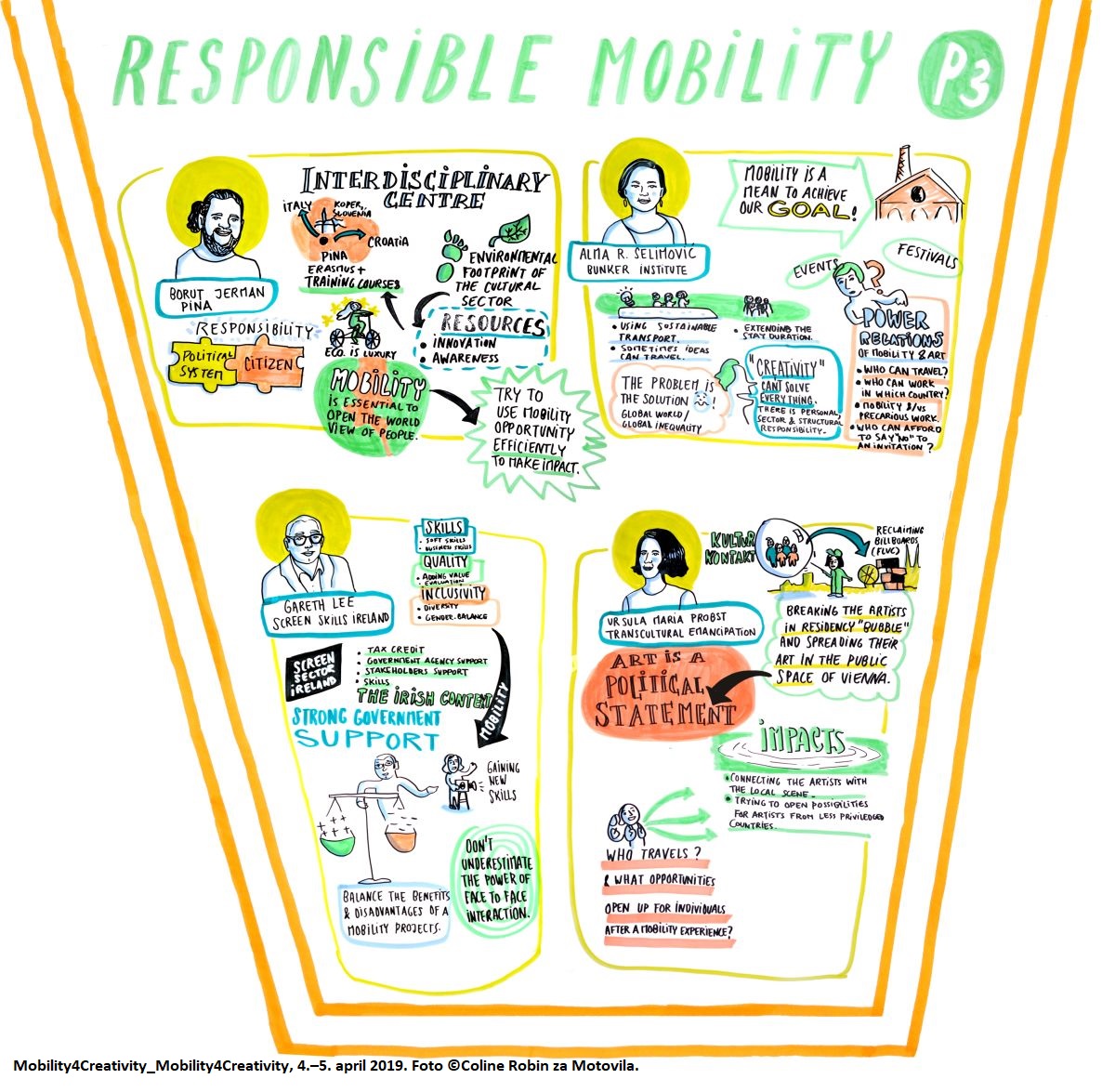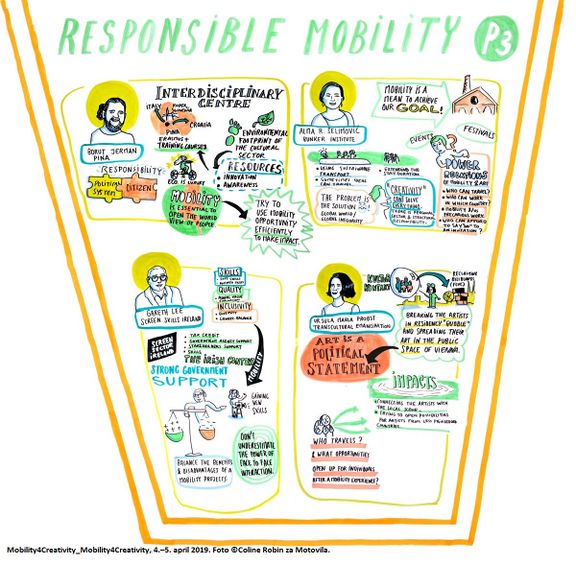Reinventing International Mobility
How do we approach mobility in the new normal?
The (recent) past
In April 2019, just nearly two years ago, when discussing international mobility in the CCS[1], we were aware of the necessity to rethink mobility in terms of cultural diversity, accessibility, and especially ecological responsibility and sustainability. We cautiously wondered how to reduce travelling and travel more responsibly. By posing the simple question
Just how dirty is your journey?
pioneering climatologist Dr Lučka Kajfež Bogataj made us more conscious in considering environmental implications (Mobility4Creativity, 2019).
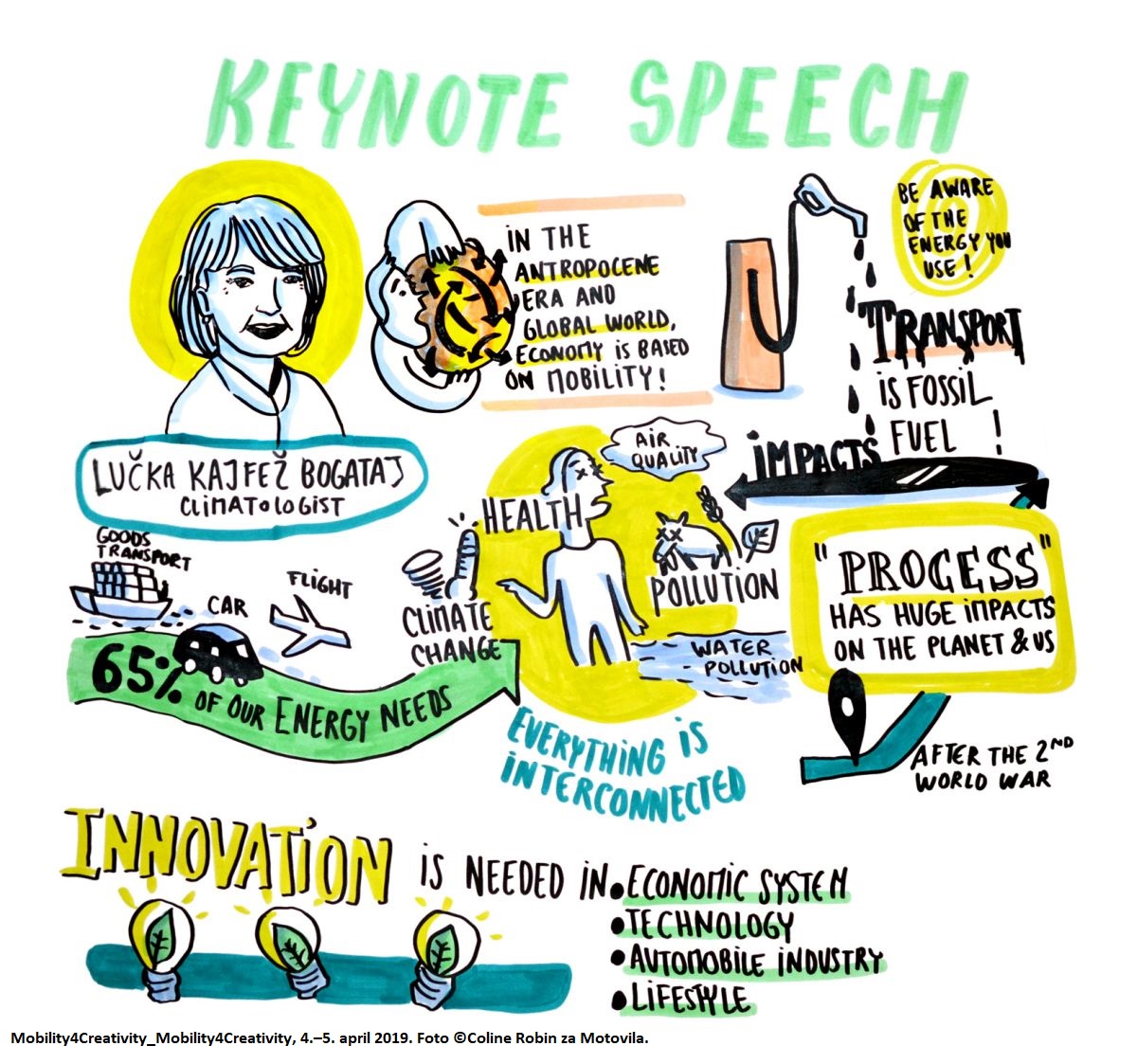 Lučka Kajfež Bogataj's infographic by Coline Robin, from the Motovila/CED Slovenia conference "Mobility4Creativity" in 2019.
Lučka Kajfež Bogataj's infographic by Coline Robin, from the Motovila/CED Slovenia conference "Mobility4Creativity" in 2019.
The environmental impact has been promoted by various international initiatives, for instance, Creative Climate Leadership, a training programme for artists and cultural professionals to explore the cultural dimensions of climate change, and take action. Training courses piloted in Wales and Slovenia in 2017 in cooperation with the Slovene partner PINA, and supported by the Creative Europe programme, have been taking place worldwide.
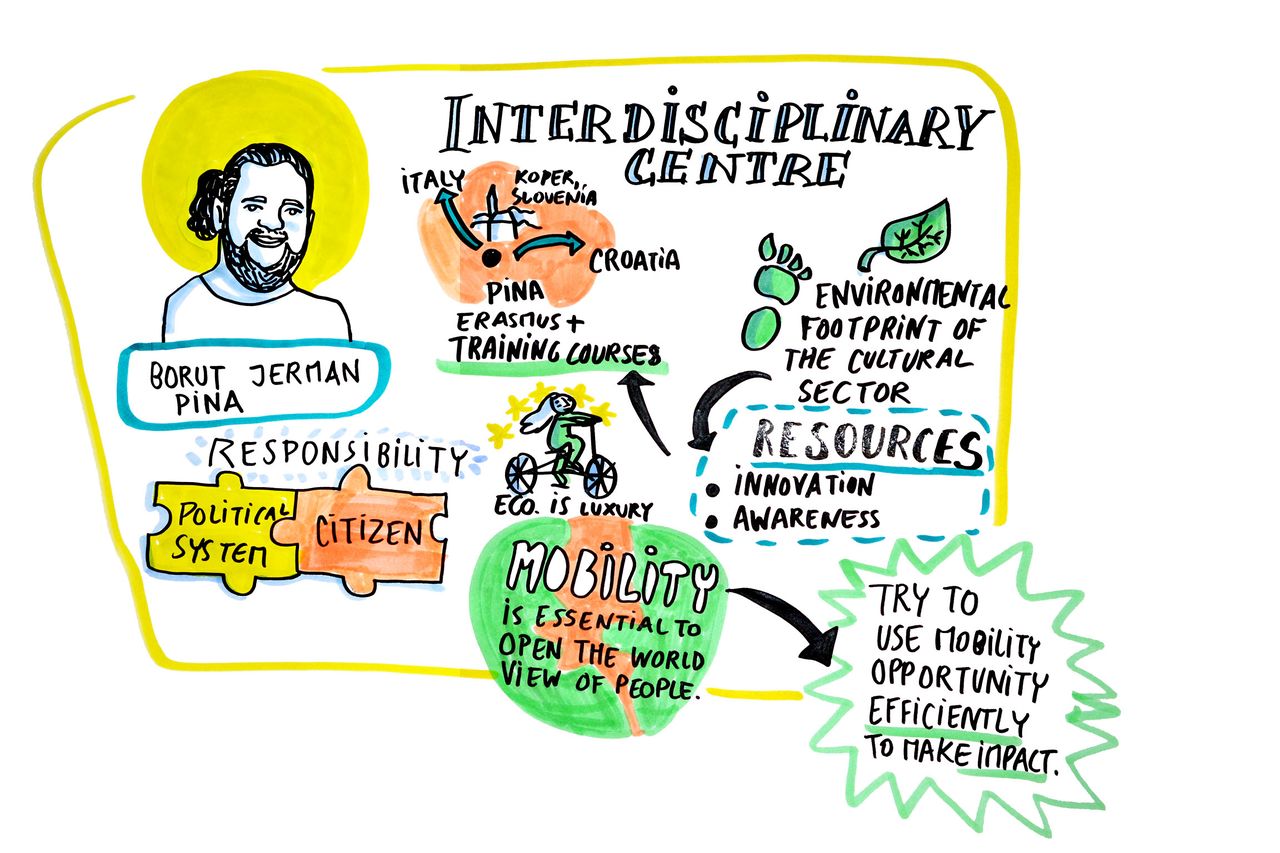 Borut Jerman's infographic by Coline Robin, from the Motovila/CED Slovenia conference "Mobility4Creativity" in 2019.
Borut Jerman's infographic by Coline Robin, from the Motovila/CED Slovenia conference "Mobility4Creativity" in 2019.
Bunker Institute, one of the most internationally-connected Slovenian NGOs, also has a long tradition of contributing to raising awareness on the climate crisis. Currently, they are involved in the project ACT (Art, Climate, Transition) bringing together European performing arts venues and festivals with the aim of supporting artworks that touch on the causes and consequences of climate change. Together, they encourage mobility of artists and explore new ways of production with a minimal environmental impact.
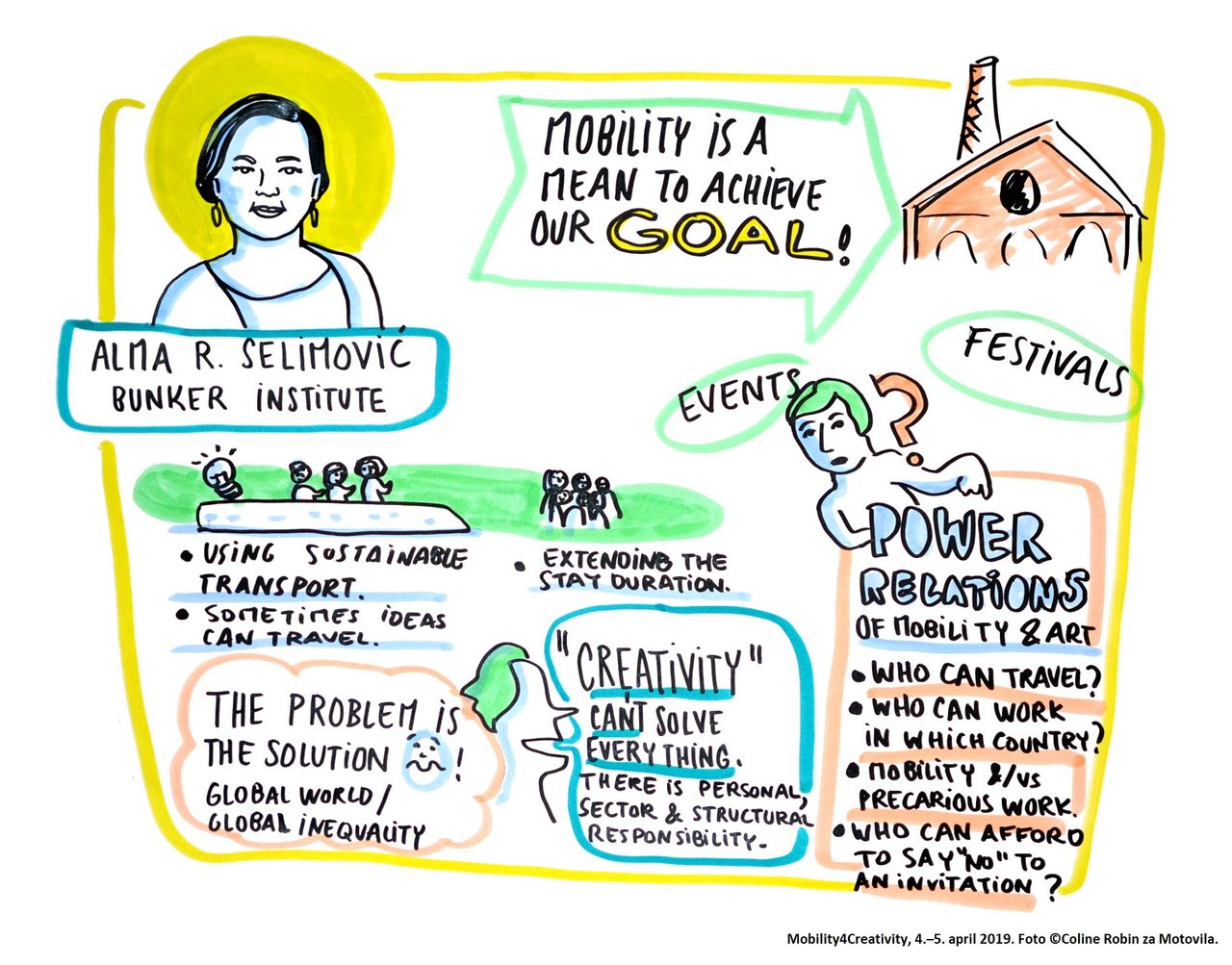 Alma Selimović's infographic by Coline Robin, from the Motovila/CED Slovenia conference "Mobility4Creativity" in 2019.
Alma Selimović's infographic by Coline Robin, from the Motovila/CED Slovenia conference "Mobility4Creativity" in 2019.
From questioning our motives for and methods of engaging in mobility in 2019, we ended up thinking when (if ever) we'll be able to travel again in 2021. The small virus that suddenly changed the entire world has interfered in our work and social lives and cancelled or very much limited our cross-border travels.
The present
The fact that the pandemic reached an unimaginable degree has significantly changed means and practices of mobility. Crossing borders is nearly impossible or at least more difficult; numerous safety requirements have made mobility more expensive and therefore even less accessible. For many artists and cultural professionals, mobility means work, bringing sources of one's livelihood! But cancelled cultural events means cancelled work opportunities.
Despite the difficult living and working conditions, the pandemic also has some positive effects. For many, the changed circumstances are an opportunity to reconsider practices, try out new genres, reach new audiences with new tools, channels and stories. Online events may bring international attention to artists that have not come to the fore before. Many institutions that promote, advocate or support international mobility have been adapting their work or funding schemes (e.g., the EU Creative Europe programme, i-Portunus, MobilityFirst!). We see more flexibility in terms of duration, mobility destination (including online!) as well as a shift in topics. Funders have also begun to enable hybrid, blended formats of mobility.
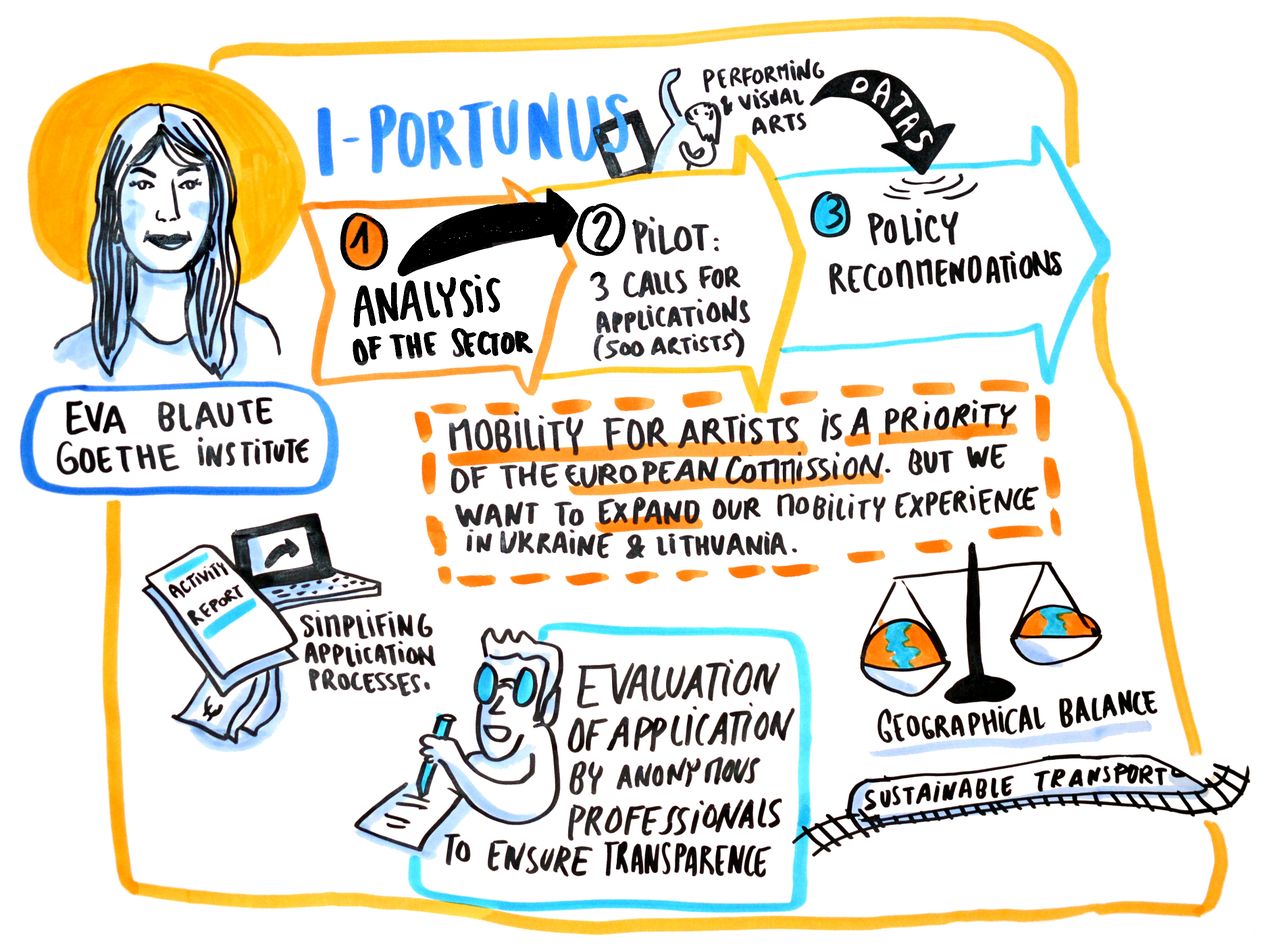 Eva Blaute's infographic by Coline Robin, from the Motovila/CED Slovenia conference "Mobility4Creativity" in 2019.
Eva Blaute's infographic by Coline Robin, from the Motovila/CED Slovenia conference "Mobility4Creativity" in 2019.
One such example is i-Portunus, the EU's valued mobility scheme for culture, supported by the Creative Europe programme. Since 2019, it is continuing to test different approaches to supporting short-term mobility of artists and cultural professionals. Just as mobility was a priority of the previous Creative Europe programme (2014–2020), it remains one for the new programme (2021–2027), which will bring innovative changes in what kind of mobility experiences will be funded and how. Therefore, the 2021 edition of i-Portunus supports mobility primarily aimed at international collaboration, professional development and production-oriented residencies. Also, it allows blended mobility, that is,
virtual international collaboration with the destination country, or other forms such as remote residency, virtual mobility.
The future
It remains to be seen whether the novel coronavirus managed to refocus our minds in order to create a more sustainable world. There are still many questions to be answered: What should be the motivation for mobility? Should we simply adapt to the "new normal"? How do we approach short or long-term mobility? How to tackle digital cooperation and e-mobility?[2]
As mobility is a key component of international cooperation, in the long run, artists and cultural professionals need to be mobile again. Without cross-border exchange they may lack collaborative international partnerships, training, markets, resources, audiences. Until the time this will again be possible, it is crucial to continue conversations on mobility – including sustainable and green mobility, to spread the word and share information about meetings, training, funding calls and other opportunities. It is also necessary to collect relevant data on the ground (map, survey) so that funders, politicians, stakeholders, etc., can better understand the complex and changing working conditions, the varieties of national contexts and dynamics affecting the culture and creative sector.
What could be temporary and innovative solutions? How should systemic and technical support (i.e. mobility funds, information and consultancy provision) be adapted and what kind of mobility experiences will and should be supported and how?
 Fatima Avila's infographic by Coline Robin, from the Motovila/CED Slovenia conference "Mobility4Creativity" in 2019.
Fatima Avila's infographic by Coline Robin, from the Motovila/CED Slovenia conference "Mobility4Creativity" in 2019.
The most important first step would be to reconsider mobility from the perspective of creative professionals as well as decision-makers – to imagine safer and more sustainable mobility in the future. Here are some starting points to take into consideration:
- think about your motivation, and optimise your mobility experience and learn from it;
- focus on what the CCS needs (e.g., open spaces, especially for young artists, and support them) and involve artists in the process of re-evaluating the system;
- respect copyrights and provide fair payment for digital content and events;
- consider new formats of mobility (hybrid, blended) and adjust the traditional formats;
- avoid simply transferring budgets from live events productions to digital events;
- adopt sustainability and green policy measures for any means of mobility;
- improve communication between different players – artists, cultural professionals, decision-makers, funders, etc.;
- exchange information, practices, knowledge.
Above all, climate change should be highly prioritised in all the recovery plans. Dr Kajfež Bogataj calls for urgent institutional, infrastructural, economic, technological and social innovations to contribute to sustainable and responsible mobility. These innovations can also be provided by the cultural and creative sectors.
For instance, RESHAPE partners coming from a dozen countries across Europe (including Bunker from Slovenia) and supported by Creative Europe, are convinced that artists and cultural workers are innovation experts, that they are the ones who should invent future models for the arts sector. The aim of RESHAPE is to imagine an alternative to the European arts ecosystem by rethinking its instruments and collaborative models, placing them in line with artistic and social innovation and the principles of fairness, solidarity, geographic balance and sustainability.
Along with many others, this initiative affirms our belief in the power of European cultural cooperation. Nevertheless, we're aware of the burning necessity to, individually and collectively, question our mobility per se – its purpose, inclusiveness, destinations, duration, carbon footprint … and contribute the "reshaped" pieces in the puzzle constituting the different mobility of the future. Only by questioning the role of mobility in our activities, might we bring mobility habits and desires into balance with the pressing need to live within environmental limits.
Author bios
Mateja Lazar is a specialist in the field of international cultural cooperation, co-founder and director of Motovila Institute and the head of the Creative Europe Desk Slovenia, hosted by Motovila. Tanja Kos shares information for Motovila on key challenges related to cultural policies and international relations.
- ↑ Mobility4Creativity, 2019, https://motovila.si/en/mobilnost-za-ustvarjalnost-kljucna-je-odgovornost/
- ↑ For further reading see Mobility4Creativity, 2020, https://motovila.si/en/useful-sources/mobility4creativity-2020-re-think-mobility-report-video/


